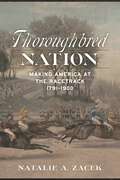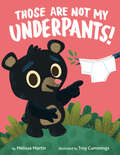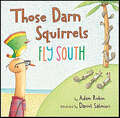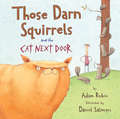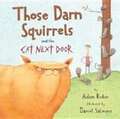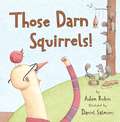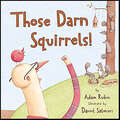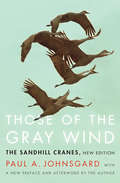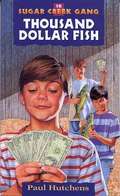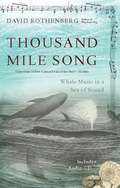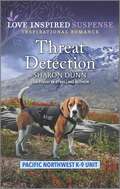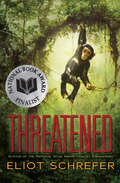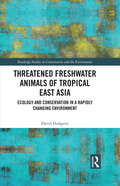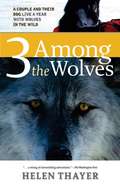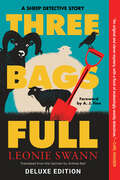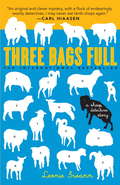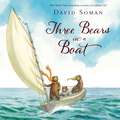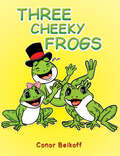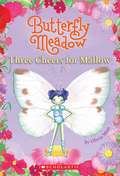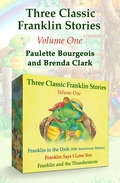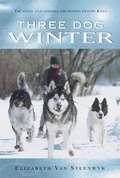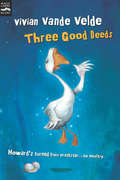- Table View
- List View
Thoroughbred Nation: Making America at the Racetrack, 1791-1900
by Natalie A. ZacekFrom the colonial era to the beginning of the twentieth century, horse racing was by far the most popular sport in America. Great numbers of Americans and overseas visitors flocked to the nation’s tracks, and others avidly followed the sport in both general-interest newspapers and specialized periodicals. Thoroughbred Nation offers a detailed yet panoramic view of thoroughbred racing in the United States, following the sport from its origins in colonial Virginia and South Carolina to its boom in the Lower Mississippi Valley, and then from its post–Civil War rebirth in New York City and Saratoga Springs to its opulent mythologization of the “Old South” at Louisville’s Churchill Downs, home of the Kentucky Derby. Natalie A. Zacek introduces readers to an unforgettable cast of characters, from “plungers” such as Virginia plantation owner William Ransom Johnson (known as the “Napoleon of the Turf”) and Wall Street financier James R. Keene (who would wager a fortune on the outcome of a single competition) to the jockeys, trainers, and grooms, most of whom were African American. While their names are no longer known, their work was essential to the sport. Zacek also details the careers of remarkable, though scarcely remembered, horses, whose achievements made them as famous in their day as more recent equine celebrities such as Seabiscuit or Secretariat. Based upon exhaustive research in print and visual sources from libraries, archives, and museums across the United States, Thoroughbred Nation will be of interest both to those who love the sport of horse racing for its own sake and to those who are fascinated by how this pastime reflects and influences American identities.
Those Are Not My Underpants!
by Melissa MartinSomeone lost their underpants! There, dangling from that tree branch! Are they YOURS? New York Times bestselling author/illustrator of Can I Be Your Dog?, Troy Cummings, brings to life Melissa Martin's gentle but hilarious read aloud, filled with silliness and gleeful anticipation of THE END.One morning, Bear Cub wakes up and finds underwear hanging on a tree limb. Who could they belong to? Ever inquisitive, he sets out on a quest through the forest to find the tighty whities' rightful owner. Could the underpants belong to Squirrel? Moose? Snake, maybe? Salmon?! Each animal denies that the bloomers belong to them, but readers will surely be giggling every step on the way...especially when they find out who the underpants actually belong to.Award-winning illustrator Troy Cummings delivers his signature warmth and humor to what could have been a very embarassing tail, er, I mean TALE, by author and child therapist Melissa Martin.
Those Darn Squirrels Fly South
by Adam RubinFrom the creators of Dragons Love Tacos comes the third off-the-wall comedy featuring Old Man Fookwire, a lot of birds, and those darn squirrels. Old Man Fookwire's one pleasure in life is painting the birds in his backyard. When fall arrives and the birds fly south, Fookwire is desolate. The squirrels are curious: Where are the birds going, and what do they do once they get there? With their usual ingenuity and engineering skills, the squirrels devise a way to follow the birds to their destination, a tropical paradise. A wonderful time is had by all—all but grumpy Old Man Fookwire, alone at home. But the squirrels have a solution for that, too. Readers will revel in this third off-the-wall comedy featuring Old Man Fookwire, a lot of birds, and those darn squirrels.
Those Darn Squirrels and the Cat Next Door
by Adam Rubin Daniel SalmieriAll is calm in old man Fookwire's yard until new neighbors--Little Old Lady Hu and her cat, Muffins--move in next door. Muffins is one mean dude! He terrorizes the birds, interrupts Fookwire's painting, and ties the squirrels' tails together. Fookwire is upset, but not nearly as upset as the squirrels, who devise an ingenious plan to stop Muffins cold. In this hilarious follow-up to Those Darn Squirrels!, the tongue-in-cheek text is perfectly complemented by the quirky, inventive illustrations.
Those Darn Squirrels and the Cat Next Door
by Adam RubinFrom the creators of Dragons Love Tacos comes the second laugh-out-loud story about Old Man Fookwire and the those darn squirrels! All is calm in old man Fookwire&’s yard until new neighbors—Little Old Lady Hu and her cat, Muffins—move in next door. Muffins is one mean dude! He terrorizes the birds, interrupts Fookwire&’s painting, and ties the squirrels&’ tails together. Fookwire is upset, but not nearly as upset as the squirrels, who devise an ingenious plan to stop Muffins cold. In this hilarious follow-up to Those Darn Squirrels!, the tongue-in-cheek text is perfectly complemented by the quirky, inventive illustrations.
Those Darn Squirrels!
by Adam Rubin Daniel SalmieriThe story of what happens when a grumpy old man and some mischievous squirrels match wits—with hilarious results. Old Man Fookwire is a grump who only likes to paint pictures of birds that visit his backyard. The problem is, they fly south every winter, leaving him sad and lonely. So he decides to get them to stay by putting up beautiful birdfeeders filled with seeds and berries. Unfortunately, the squirrels like the treats, too, and make a daring raid on the feeders. The conflict escalates—until the birds depart (as usual), and the squirrels come up with a plan that charms the old grump.
Those Darn Squirrels!
by Adam RubinLittle ones and grown-ups will giggle through multiple reads of Those Darn Squirrels!From the creators of Dragons Love Tacos comes the story of what happens when a grumpy old man and some mischievous squirrels match wits—with hilarious results.Old Man Fookwire is a grump. The only thing he likes to do is paint pictures of the birds that visit his backyard. The problem is, they fly south every winter, leaving him sad and lonely.So he decides to get them to stay by putting up beautiful bird feeders filled with seeds and berries. Unfortunately, the squirrels like the treats, too, and make a daring raid on the feeders. The conflict escalates—until the birds depart (as usual), and the squirrels come up with a plan that completely charms the old grump.The three funny picture books in this series from Adam Rubin and Daniel Salmieri:Those Darn SquirrelsThose Darn Squirrels and the Cat Next DoorThose Darn Squirrels Fly South
Those of the Gray Wind: The Sandhill Cranes, New Edition
by Paul A. JohnsgardWith Paul A. Johnsgard, we follow the migration of the sandhill cranes from the American Southwest to their Alaskan breeding grounds and back again, an annual pattern that has persisted over millions of years. By selecting four historic time frames of the migration between 1860 and 1980, Johnsgard illustrates how humans have influenced the flocks and how different American cultures have variously responded to the birds and perceived their value. Each section focuses on the interactions between children of four different American cultures and sandhill cranes, triggered by events occurring during the annual life cycle of the cranes. The story is enriched by the author’s exquisite illustrations, by Zuni prayers, and by Inuit and Pueblo legends. With a new preface and afterword and a new gallery of photographs by the author, Those of the Gray Wind is a classic story of a timeless ritual that can be enjoyed for generations to come.
Thousand Dollar Fish (Sugar Creek Gang #15)
by Paul HutchensAn incredible discovery in an icehouse leads to an encounter with a criminal. Will the police come quickly enough to catch the man the gang trapped? Will the gang be able to deliver an important letter from Little Tom Till's mom before it's too late? In this tale from northern Minnesota the gang learns about several kinds of fishing, the most important being fishing for men. The Sugar Creek Gang series chronicles the faith-building adventures of a group of fun-loving, courageous Christian boys. These classic stories have been inspiring children to grow in their faith for more than five decades. More than three million copies later, children continue to grow up relating to members of the gang as they struggle with the application of their Christian faith to the adventure of life. Now that these stories have been updated for a new generation, you and your child can join in the Sugar Creek excitement.
Thousand-Mile Song
by David RothenbergIn Thousand Mile Song, musician and philosopher David Rothenberg uses the enigma of whale sounds to explore whether we can truly understand nonhuman minds. Interviewing scholars around the world as they attempt to decipher underwater music, Rothenberg tells the story of scientists and artists confronting an unknown as vast as the ocean. Along the way, he plays his clarinet live with whales in their native habitats, from Russia to Hawaii, making interspecies music that appears on the included CD. Richly detailed and deeply entertaining, Thousand Mile Song is an imaginative look at the most intriguing creatures of the ocean.
Threat Detection (Pacific Northwest K-9 Unit #5)
by Sharon DunnCan a K-9 team stop an assailant with a deadly plan? When someone shoots at volcanologist Aubrey Smith on Mount St. Helens, it&’s up to K-9 officer Isaac McDane to protect her even though she broke his heart a decade ago. But as people keep dying and signs point to Aubrey&’s sister being involved or the next potential victim, they&’ll have to work together to track down the killer before he finishes his hit list.From Love Inspired Suspense: Courage. Danger. Faith.Pacific Northwest K-9 Unit Book 1: Shielding the Baby by Laura ScottBook 2: Scent of Truth by Valerie HansenBook 3: Explosive Trail by Terri ReedBook 4: Olympic Mountain Pursuit by Jodie BaileyBook 5: Threat Detection by Sharon DunnBook 6: Cold Case Revenge by Jessica R. PatchBook 7: Undercover Operation by Maggie K. BlackBook 8: Snowbound Escape by Dana Mentink
Threatened (Ape Quartet #2)
by Eliot Schrefer*A 2014 NATIONAL BOOK AWARD FINALIST*When he was a boy, Luc's mother would warn him about the "mock men" living in the trees by their home -- chimpanzees whose cries would fill the night.Luc is older now, his mother gone. He lives in a house of mistreated orphans, barely getting by. Then a man calling himself Prof comes to town with a mysterious mission. When Luc tries to rob him, the man isn't mad. Instead, he offers Luc a job.Together, Luc and Prof head into the rough, dangerous jungle in order to study the elusive chimpanzees. There, Luc finally finds a new family -- and must act when that family comes under attack.As he did in his acclaimed novel ENDANGERED, a finalist for the National Book Award, Eliot Schrefer takes us somewhere fiction rarely goes, introducing us to characters we rarely get to meet. The unforgettable result is the story of a boy fleeing his present, a man fleeing his past, and a trio of chimpanzees who are struggling not to flee at all.
Threatened Freshwater Animals of Tropical East Asia: Ecology and Conservation in a Rapidly Changing Environment (Routledge Studies in Conservation and the Environment)
by David DudgeonThis book offers a comprehensive account of the current state of inland waters in tropical and subtropical East Asia, exploring a series of case studies of freshwater fish, reptiles, amphibians, birds, mammals and water bodies at particular risk. The book highlights the rich freshwater biodiversity of tropical East Asia and draws attention to the various threats it faces due to human activities and rapid environmental change. It addresses the question of whether the contributions of these animals and habitats, or biodiversity in general, to ecosystem functioning and service provision provide sufficient basis for arguments supporting nature conservation. Drawing on instances from the rivers and lakes of tropical East Asia, the book also asks whether the benefits accruing from intact ecosystems are likely to be enough to ensure their preservation. If the answer to either or both these questions is ‘no’, then what are the prospects for freshwater biodiversity in rapidly changing tropical East Asia? This book will be of interest to students and scholars of biodiversity, conservation, freshwater ecology, ecosystem services and Asian Studies.
Three Among the Wolves: A Couple and Their Dog Live a Year with Wolves in the Wild
by Helen ThayerHelen and Bill Thayer, accompanied by their part-wolf, mostly Husky dog, Charlie, set out to live among wild wolf packs -- first in the Canadian Yukon and then in the Arctic. When they set up camp within 100 feet of a wolf den, they were greeted with apprehension. But they establish trust over time because the wolves accept Charlie as the alpha male of the newly arrived "pack." Readers travel with the Thayers as they learn about wolf family structure, view the intricacies of the hunt, the wolves' finely honed survival skills, and playfulness.
Three Baby Spiders (Fountas & Pinnell Classroom, Guided Reading)
by Jacqueline Adams Xiao XinNIMAC-sourced textbook. Growing Up. Three baby spiders want to be big spiders. But being big isn't always easy.
Three Bags Full (A Sheep Detective Story)
by Leonie SwannSoon to be a major motion picture starring Hugh Jackman and Emma Thompson, this funny and surprising mystery features a new breed of detectives you&’ve got to read to baaaaa-lieve.This twentieth-anniversary deluxe paperback features a foreword by A. J. Finn, discussion questions, and more.Something is not right with George the shepherd. His sheep have gathered around him outside the cozy Irish village of Glennkill to assess the situation. George has cared for the sheep, reading them books every night, and now he lies pinned to the ground with a spade. His flock, far savvier about the workings of the human mind than your average sheep, sets out to find George&’s killer, led by Miss Maple, the smartest sheep in Glennkill (and possibly the world).Her team of investigators includes Othello, who was rescued from the Dublin Zoo; Mopple the Whale, who is always hungry and remembers everything; and Zora, an existential ewe—just to name a few. Together, the sheep discuss the crime late into the night, and their speculations vary wildly. Determined to unravel the mystery, they embark on furtive missions into the village, where they encounter a hoof-full of two-legged suspects. There&’s Ham, the terrifying butcher who smells of death; Rebecca, the secretive village newcomer; and Father Will, a sinister priest the sheep call God.With wit and heart, this clever international bestseller is a mystery to chew on—and savor.
Three Bags Full: A Sheep Detective Story
by Leonie SwannA witty philosophical murder mystery with a charming twist: the crack detectives are sheep determined to discover who killed their beloved shepherd.On a hillside near the cozy Irish village of Glennkill, a flock of sheep gathers around their shepherd, George, whose body lies pinned to the ground with a spade. George has cared devotedly for the flock, even reading them books every night. Led by Miss Maple, the smartest sheep in Glennkill (and possibly the world), they set out to find George's killer. The A-team of investigators includes Othello, the "bad-boy" black ram; Mopple the Whale, a Merino who eats a lot and remembers everything; and Zora, a pensive black-faced ewe with a weakness for abysses. Joined by other members of the richly talented flock, they engage in nightlong discussions about the crime, wild metaphysical speculations, and embark on reconnaissance missions into the village, where they encounter some likely suspects. Along the way, the sheep confront their own all-too-human struggles with guilt, misdeeds, and unrequited love. Funny, fresh, and endearing, it introduces a wonderful new breed of detectives to Canadian readers.From the Hardcover edition.
Three Bears in a Boat
by David SomanFrom the co-creator of the New York Times bestselling Ladybug Girl series comes a high seas adventure inspired by the classic picture books Little Bear and Where the Wild Things Are. Three bear siblings break their mother’s favorite blue seashell, and rather than tell her, they decide to set out in their sailboat to find her a new one. On their quest they encounter salty sailors, strange new islands, huge whales, and vast seas but no blue seashells. When a treacherous storm suddenly blows in, the three bears find themselves tossed about in their little boat, far from Mama. What will become of their search, and what will it take to bring them safely home? This read aloud shares its best qualities with classic picture books: breath-taking illustrations, epic adventure, and a subtle message about taking responsibility for your actions.
Three Cheeky Frogs
by Conor BeikoffThree Cheeky Frogs weaves a delightful tale of frolicsome amphibians whose antics spell endless mischief for three unsuspecting siblings. As the frogs’ pranks grow more audacious, the children tread with caution. Which playful ruse will they stumble into next? Dive into this enchanting narrative and embark on a rib-tickling adventure with the most playful frogs in town!
Three Cheers for Mallow! (Butterfly Meadow #3)
by Olivia MossZip is organizing a sports day in the field. All of the different insects and animals are going to take part! Dazzle is happy to cheer on her friends. But when one of the butterflies can't compete, will Dazzle be brave enough to take her place?
Three Classic Franklin Stories, Vol. 1: Franklin in the Dark (25th Anniversary Edition), Franklin Says I Love You, and Franklin and the Thunderstorm
by Paulette Bourgeois Brenda Clark<p>Three storybooks in one: Meet the lovable turtle who inspired the beloved Franklin and Friends TV show! <p><i>Franklin in the Dark</i>. In the Franklin Classic Storybook that started it all, poor little Franklin has one of the most common childhood afflictions—he is afraid of the dark. This is particularly difficult for Franklin as he happens to be a turtle, and the darkness he fears is, of course, inside his own shell. Bravely, with shell in tow, he sets forth to seek help and in the course of his travels discovers a bird who is afraid of heights, a polar bear who is afraid of the cold, and even a hydrophobic duck. In the end, Franklin discovers that everybody, even his own mother, is afraid of something, and his response to what he has learned is guaranteed to draw a smile. <p><i>Franklin Says I Love You</i>. In this Franklin Classic Storybook, our hero is a very lucky turtle. He has the best friends, the best little sister, the best goldfish, and, of course, the best mother. But when he discovers that his mother’s birthday is coming up, he can’t find the best present. After giving it some serious thought, Franklin decides to do everything for his mom. On the morning of her birthday he takes her breakfast in bed, makes a brooch, draws a picture, and cuts fresh flowers from the garden! And then Franklin gives his mom a great big hug and says, “I love you”—which is, of course, the best gift of all. <p><i>Franklin and the Thunderstorm</i>. In this Franklin Classic Storybook, Franklin is afraid of thunderstorms. When a storm approaches while he is playing at Fox’s house, a flash of lightning sends Franklin into his shell. He refuses to come out—even for snacks—until his friends make him laugh with their tall tales about what causes storms. And when Beaver explains what really causes thunder and lightning, Franklin begins to feel much safer.
Three Dog Winter
by Elizabeth Van SteenwykSled-dog racing means everything to Scott McClure. It also helps keep his father's memory alive. Scott plans to form a new team of three sled dogs so that he can continue racing and become a champion like his dad. But life changes quickly when his mother remarries and they move from California to Montana. From the start, Scott has problems with his stepfather and his stepbrother, Brad. Scott won't let anything interfere with his dreams as he trains and races Kaylah, his Malamute, and the other dogs on the team. But Scott doesn't know the obstacles he must face.
Three Ducks Went Wandering
by Ron RoyIn this gentle yet suspenseful story, three adventurous little ducklings wander away from their barnyard home and unwittingly avoid disaster after disaster until they eventually return to the nest, where their mother takes them under her wing for a nap.
Three Good Deeds
by Vivian Vande VeldeIf Howard had known the old hag was a witch, he never would have taunted her. But he did, and she did what witches do--cursed him--and now he's a goose! Howard is desperate to become a human again. But the only way to break the curse is to do three good deeds. How can you help others when you've got webbed feet, wings for hands, and can't say anything but "Honk"?
